I am flying over the Iraqi desert in a half empty medium sized aircraft. The closest passenger is three rows behind me and snoring loudly. My GPS freezes after leaving Turkish airspace, so I play a game of looking out the window to guess where I am. While I am probably somewhere between Dohuk and Erbil, the surface below reminds more of Mars than anything else. An endless series of cracked canyons is embedded between thin mountain chains in the otherwise flat desert. These thin scars stretch between both horizons.
As we begin our descent, I start to notice long white columns of smoke rising from the mountains below. The smoke is organic, the product of burning farmland. It is a refreshingly natural sight. Burning crop waste has been practiced by farmers since prehistoric times in order to fertilize the next crop.
In the distance I see more smoke. This time in the form of a black mushroom could, an indication of a bomb or air strike hitting somewhere in the direction of Mosul.
As we get closer to Erbil, haze from the dozens of oil refineries below trickles into the air, forming an opaque grey ocean between the plane and the airport. “Welcome to Erbil,” says the pilot over the loudspeaker, “the current temperature is 50 degrees (122 Fahrenheit). We hope you’ve enjoyed your flight.” The plane drops into the grey ocean like a star falling into a camp fire. In the muddy air I make out the skyline of this once booming oil city.
Although I bought the plane ticket to Iraq on a whim a couple weeks before, I was always drawn this country. I had been interested in Iraq since I was a child. When I was four years old, Bush launched the US into the first Gulf War. While my playmates were intrigued by plastic superheroes like Superman and the Turtles, I was obsessed with Saddam Hussein. The idea that absolute evil could have absolute power was fascinating because I felt that absolute good is by its nature, was unable to have absolute power.
The week the US began its invasion of annexed Kuwait, I bought a miniature army set and constantly re-enacted Saddam Hussein’s world, obsessing over the details of military purges and the placement of troops during his invasion and inevitable retreat.
Now I was here in Iraq: a land which has not only been miniaturized through my toys, but also miniaturized through the lens of newspapers, and through distance, politics, language and cultural barriers. Finally, this land was beginning to expand from outside my airplane window.
—
The Black, the Grey, and the White; A brief exploration of the three cities of Iraqi Kurdistan.
This is going to be a different kind of travel essay. First of all, it will be written in three parts, out of order. For example, I visited Erbil first, but I will speak about it now, in this second part.
Second, I will only write about what I saw and heard. If I were to begin writing about the history of these cities, I might as well begin writing an encyclopedia. Erbil alone, is considered by some archaeologists to be the first city in the history of the world. It’s hard to fathom how much culture and yore these cities have accumulated.
Third, again, unlike good journalism, I am not going to write the truth. I’m only going to write what I was told, read, and saw. Perhaps I’m spending too much time in the Middle East, or perhaps it’s my upbringing in a cult, but I believe in order to understand people and cultures, I have to understand their truths separately from the facts. If everyone acts on a truth that diverges from reality, how valuable is that truth compared to reality? When studying history, the facts mean everything. When observing culture, facts are things that usually get in the way.
—
Part Two
The Grey: Erbil
—
There is a grey chemical haze that envelops Erbil like a fog cap on a mountain. The haze comes from three main sources; oil refineries, car exhaust, and generators. The oil refineries around Erbil have transformed the parched land into a sunny Mordor. It is hard to imagine so much smoke being pumped into the air by anything other than a chain of active volcanoes. Yet, as disturbing as these refineries are, they are the lifeblood of this nation.
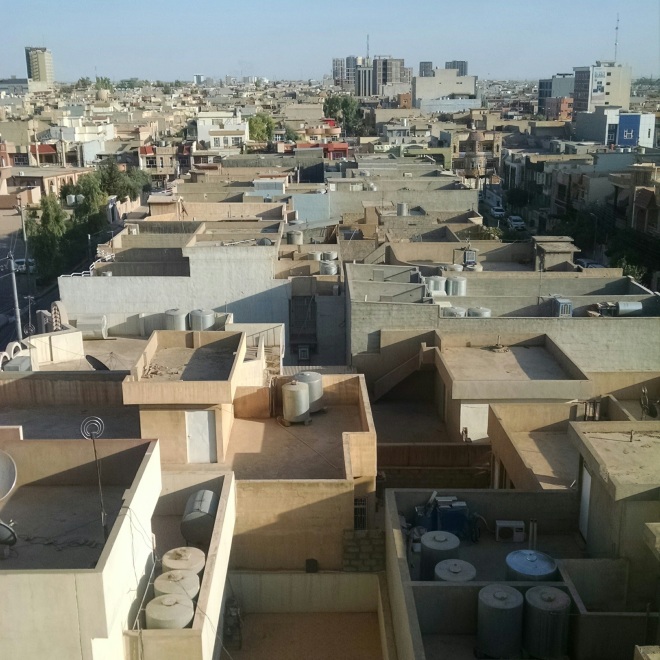
Erbil is one of the oldest, if not the oldest city, in the world. Although in its current incarnation, the city has become a tiny Los Angeles. Its streets are as wide as freeways. Its layout requires cars, yet there is no public transportation. The seemingly unregulated exhaust from the endless stream of traffic puts a layer of dusty particles on everything, including my skin, which made me feel like I was living in a drizzle of soot.
While the refineries and cars do some unfortunate things to Erbil’s atmosphere, I believe it’s the generators that do the real damage. The power goes out in Erbil once or twice an hour which prompts thousands of diesel generators to simultaneously turn on, making the inside of houses and hotel rooms smell like the inside of train engine, and the outside a train yard. This said, I suppose one gets used to the air, and it’s the worst in the Summer.
Although most Iraqi-Kurdistan was astonishingly in tune with its surroundings, Erbil had an unnatural “green-zone” feel to it. Still, it was not set up for travelers. For example, there were streets lined with dozens of hotels but only one ATM in the city. And it was broken. There were rumours of a second ATM, but it was not found. There were places with names, “Italian village” , “English village” , and “Dream City,” but these were all just heavily guarded gated communities, as out of place with the rest of the city as colonies on the Moon. On top of that, much of Erbil consisted of half built cement mega structures, destined to become mountains of crumbling cement. The global oil crash has not been kind to this city.
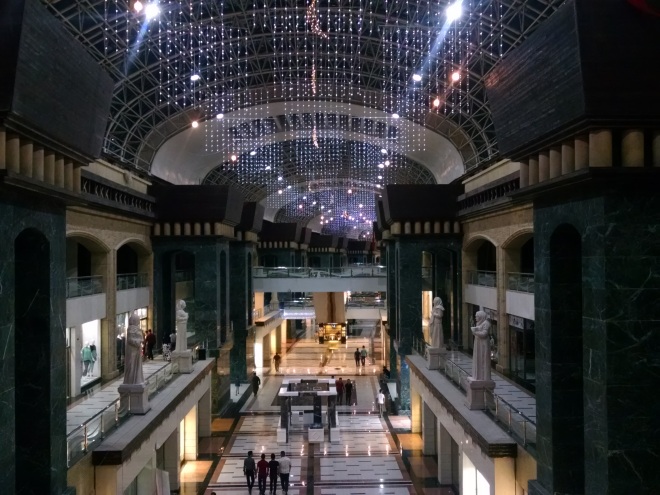
The center of the city was an exception to the ugliness. As it was the original city, it retained beauty and soul. The elaborately ornate bizarre was massive, loud, and vibrant. The citadel, raised above the rest of the city on a masa, looked too ancient to be real. The plaza below was an aesthetic refuge for the city’s population.
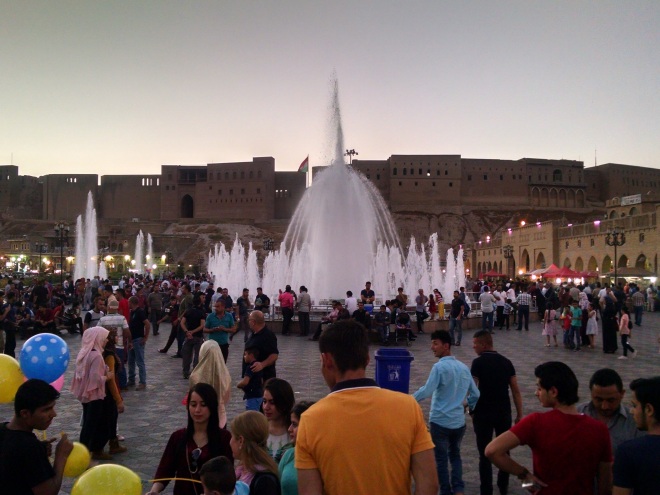
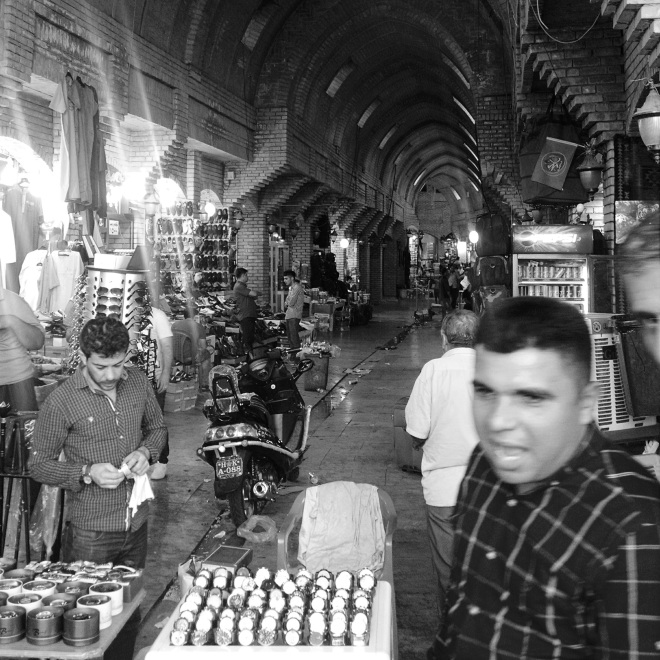
Erbil’s citizens were also an exception to its ugliness. Everyone I met was kind and thoughtful. The biggest shock came when I had to cross the giant streets. These Niles of asphalt were daunting at first. There were no crosswalks in Erbil, and if there was something that resembled a crosswalk, it was not working because of the chronic lack of electricity. Instead, pedestrians crossed the street by walking from spaces between the lanes.
In my home city of Izmir this would truly be a death sentence. However in Erbil, drivers would press the brake pedal just enough for me to run in front of their car onto the next space between lanes, until I made it all the way across the street. It was a great system. By the end of my trip I was addicted to crossing the street, thrilled at the recognition of my humanity.
Another example of Kurdish thoughtfulness came when I would attempt to buy something. I knew about five words in Kurdish. The Arabic I could speak was a different dialect, and while some people understood a little English, the typical shop owner did not.
In some cultures, not knowing the language and wanting to buy something as simple as a bottle of water, results in a clusterfuck involving a congregation of multiple shop owners, customers, and cellphone calls to the cousin that took an English class in 1982. But in Erbil, I was able to calmly explain things through hand gestures and broken Arabic, until the shop owner understood.
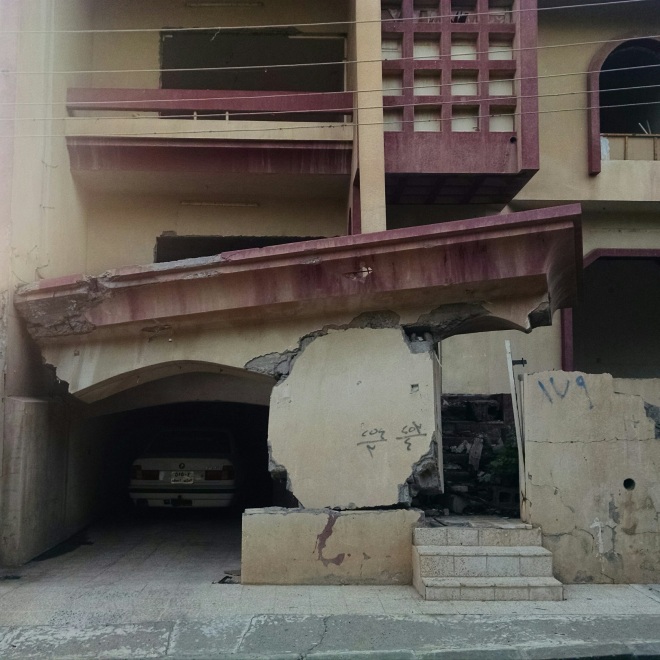
Even though Erbil did not seem like a functional or even livable city, I look back on it with affection because of the simple appreciations of my humanity – something that is rare for any city. I left Erbil after spending a little over 24 hours there. Perhaps more time would have reveled a better side, but I doubt it.
Wow!!!! What a strange, fascinating place. That sentence about trying to purchase something and not knowing the language. . . Oh, that is so true! I’m glad to see that the people of Erbil are warm and kind, despite the sooty exterior.
LikeLike